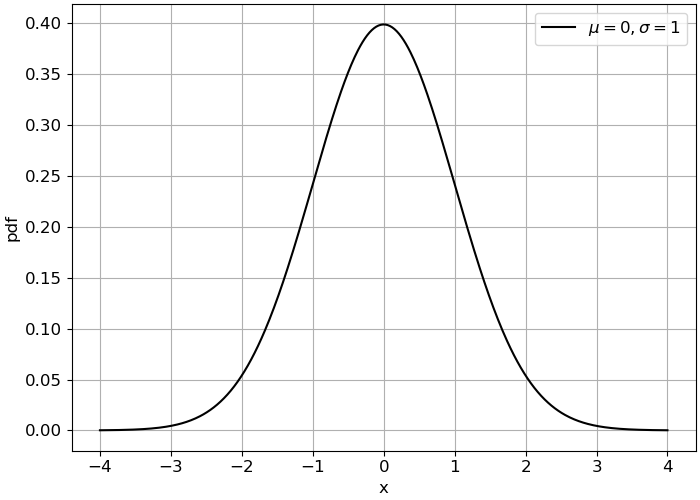3.3. Non-Gaussian distributions#
So far, you have seen that we can use an empirical distribution to model the uncertainty in our observations. Also, you have revisited the Gaussian distribution, which is a widely used model since it has lots of applications such as modelling natural processes or measurement errors. Here, we will discuss an interesting property of this distribution, the lack of asymmetry, and introduce the concept of the tail of the distribution.
Concepts of asymmetry and tail of the distribution#
Asymmetry is a relevant property of a distribution which analyzes its shape. In the Figure below, you have the PDF of a Gaussian distribution.

Fig. 3.9 Gaussian PDF.#
As you can see, the shape of the Gaussian PDF is perfectly symmetric with respect to the mode[1] of the distribution. This leads to an interesting property: for perfectly symmetric distributions, the mean[2] and median[3] have the same value. If the distribution only has a single mode, its mode will also coincide with the mean and median.
As you can imagine, it is also possible to analyze the asymmetry of an empirical distribution. To this end, we can visually inspect the empirical PDF and compute the sample coefficient of skewness from a set of samples from this distribution as
where \(x_i\) are the observations, \(\overline{x}\) is the mean of the observations, \(n\) is the number of observations, and \(\sigma\) is the standard deviation.
And what happens when my samples are not symmetric?
In that case, Gaussian distribution may not be the most appropriate model and we need to look for a different model. Actually, it is very common to find asymmetric distributions when modelling natural processes!
If we go back to the wind data that we previously introduced and have a look at the PDF, we can easily notice that it is not symmetric. The mass in the PDF is not distributed equally at both sides of the mode. Actually, the shape is similar to a bell, but we can see that the tail of the distribution decays more slowly towards the right. Since the tail expands towards positive values, we say that the PDF has positive skewness.
Fig. 3.10 Empirical PDF derived from wind speed estimates at 10m height in Delft over the past year. Hover over the bars to highlight the interval probabilities. [^ref]#
Many natural phenomena exhibit positive skewness. This means that the mode, the mean and the median do not have the same value anymore. For a positively skewed PDF: mode < median < mean. This inequality is reversed if the PDF is negatively skewed.
And why are asymmetry and tail that important?
Asymmetry is an important criteria when selecting which distribution can best model the uncertainty in our observations. The shape of the distribution needs to fit the shape of the empirical distribution function.
Moreover, the tails of the distribution are modelling the highest and lowest values of our variable and, typically, they are the ones we use for design. For instance, if we are designing a building, for the purposes of stability we would be interested in the highest wind speeds that it has to withstand (loading conditions). Also, if we are considering the nutrients required to cultivate mussels, we would analyze the lowest values we might encounter to ensure that the mussels have enough food to survive. Thus, it is important to choose a distribution which is able to model the behavior in the tail when the observations are not symmetric.
In the following sections, we will introduce parametric distributions, which use relatively simple equations containing one or more parameters to define the PDF and/or CDF. We will introduce you to some common parametric distributions, as well as the unique characteristics of each one, to give an overview of possible models you may apply to best represent your data. But keep in mind that the list is not exhaustive, there are a lot of distributions!
Attribution
This chapter was written by Patricia Mares Nasarre, Robert Lanzafame, and Max Ramgraber. Find out more here.
